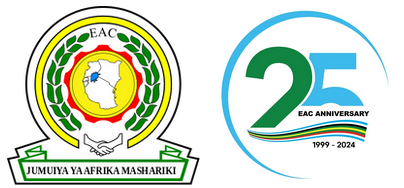
EAC readies to advance digital integration with an ambitious Cross-Border Payment System Masterplan
East African Community Headquarters, Arusha, Tanzania, 25th March, 2025: The East African Community (EAC) has taken a significant step towards revolutionising cross-border payments with the regional validation of the Draft EAC Cross-Border Payment System Masterplan.
This milestone, attained during the EAC Regional Payment Systems Steering Committee meeting held in Mombasa, Kenya from 17th to 21st March, 2025, aims to enhance the speed, security, affordability and integration of payment systems across the region.
Speaking during the meeting, the Chairperson of the Steering Committee, Mr. Michael Eganza, the Director of Banking and Payment Services at the Central Bank of Kenya, Nairobi, said that the validation of the Masterplan was a significant event towards a more integrated and efficient East African payments landscape.
“By implementing the Masterplan and the proposed initiatives, we are laying the groundwork for a seamless, cost-effective and inclusive financial ecosystem,” he added.
On his part, Mr. Aime Uwase, EAC Director of Planning, emphasised the importance of the initiative, saying that an efficient and reliable cross-border payment system was vital for regional economic growth and financial inclusion.
“The successful implementation of the EAC Cross-Border Payment System Masterplan will enhance trade, investment, and economic collaboration across the region,” said Mr. Uwase.
The Masterplan was developed through extensive consultations with the Partner States’ Central Banks and envisions a future where East Africans can conduct cross-border transactions with ease, fostering deeper economic integration and financial inclusion. Its mission is to implement a secure, efficient, and interoperable payments framework that aligns with the objectives of the EAC Monetary Union.
The strategic framework of the Masterplan is built upon four (4) key pillars:
- Governance, Legal, Regulatory, and Oversight Framework: creating harmonised regulations to enhance compliance and interoperability.
- Infrastructure: modernising and expanding payment systems to enable faster, cost-effective transactions, including enhancements to the East African Payment System (EAPS).
- Inclusivity: ensuring equitable access to payment systems for individuals, businesses, and financial institutions across all Partner States.
- Capacity Building: strengthening technical expertise and financial literacy to support sustainable modernisation efforts.
The Masterplan tackles key obstacles such as fragmented regulations, high transaction costs, and limited interoperability by outlining twenty (20) targeted initiatives. It identifies several critical challenges, including fragmented regulatory frameworks, limited interoperability between national and regional payment systems, high transaction costs, slow settlement processes, gaps in financial inclusion, and weak consumer protection mechanisms.
Additionally, challenges in cross-border data-sharing and risk management hinder the efficiency of payments across Partner States. By addressing these issues, the Masterplan seeks to create a more seamless and integrated payments ecosystem that will enhance trade, investment, and economic growth across the region.
Notably, the roadmap aligns with global best practices, including the implementation of ISO 20022 as a standardised messaging protocol to facilitate electronic data exchange between financial institutions. Further, the Masterplan proposed the exploration of Central Bank Digital Currencies (CBDCs), digital forms of a country’s fiat currency issued and regulated by the central bank, for regional transactions.
The Masterplan proposes targeted initiatives such as the development of a mutual recognition framework for cross-border Payment Service Provider (PSP) licensing and a harmonised regulatory framework for mobile money and e-wallet transactions.
The Masterplan also focuses on enhancing interoperability through a regional instant retail payment switch, fostering public-private collaboration via a regional payments system forum, and strengthening consumer protection measures. Additionally, it explores the adoption of emerging technologies such as AI and cloud computing to further modernise cross-border payments across the EAC region.
As the Masterplan identifies various targeted initiatives, the Partner States are in agreement that successful implementation requires a phased approach, ensuring that each initiative is implemented efficiently while adapting to the evolving financial and technological landscape.
In this regard, the Partner States have recommended a roadmap that provides a clear timeline for key milestones, enabling stakeholders to track progress and make necessary adjustments to optimise results. Each phase is designed to progressively enhance the region’s payment ecosystem, fostering interoperability and financial inclusion while reducing transaction costs and inefficiencies.
The rollout of the Masterplan is anticipated to occur in three (3) phases; whereby in the Short-term (1–2 years) it will address Regulatory harmonisation, foundational infrastructure upgrades, and capacity-building initiatives; Medium-term (3–5 years) it will ensure full interoperability of Partner States’ payment systems and operationalisation of the regional instant retail switch; and Long-term (beyond 5 years) it is set to enhance deeper regional integration, alignment with global payment networks, and adoption of emerging financial technologies.
To further support the implementation of the Masterplan, the Eastern Africa Regional Digital Integration Project (EARDIP) is set to play a crucial role. Funded by the World Bank, the EARDIP is set to advance digital market integration in Eastern Africa by enhancing cross-border broadband connectivity, data flows and digital trade.
The initiative consists of 4 components, including Component 3: Online Market Development and Integration. Through this component, EARDIP aims to enhance the regional online market by addressing barriers to cross-border trade and payments while investing in key digital enablers.
A core objective of this component is to improve interoperability between digital payment systems across the region, ensuring seamless cross-border transactions for goods and services. By fostering greater connectivity and financial inclusion, EARDIP is expected to contribute significantly to the success of the Masterplan, promoting a more integrated and efficient digital payments ecosystem in East Africa.
With strong backing from policymakers and development partners, the EAC Payment Systems Masterplan is set to drive economic growth, enhance financial inclusion, and position East Africa as a leader in cross-border payment innovation.
Simon Peter Owaka
Senior Public Relations Officer
Corporate Communications and Public Affairs Department
EAC Secretariat
Arusha, Tanzania
Tel: +255 768 552087
Email: This email address is being protected from spambots. You need JavaScript enabled to view it.
About the East African Community Secretariat:
The East African Community (EAC) is a regional intergovernmental organisation of eight (8) Partner States, comprising the Republic of Burundi, the Democratic Republic of Congo, the Republic of Kenya, the Republic of Rwanda, the Federal Republic of Somalia, the Republic of South Sudan, the Republic of Uganda and the United Republic of Tanzania, with its headquarters in Arusha, Tanzania. The Federal Republic of Somalia was admitted into the EAC bloc by the Summit of EAC Heads of State on 24th November, 2023 and became a full member on 4th March, 2024.
Tags: #EARDIP
